LAUNCHGOOD
VoC & CX Capability
Embedding Voice of the Customer into support operations, co-creating governance, and uplifting CX capability across the service ecosystem.
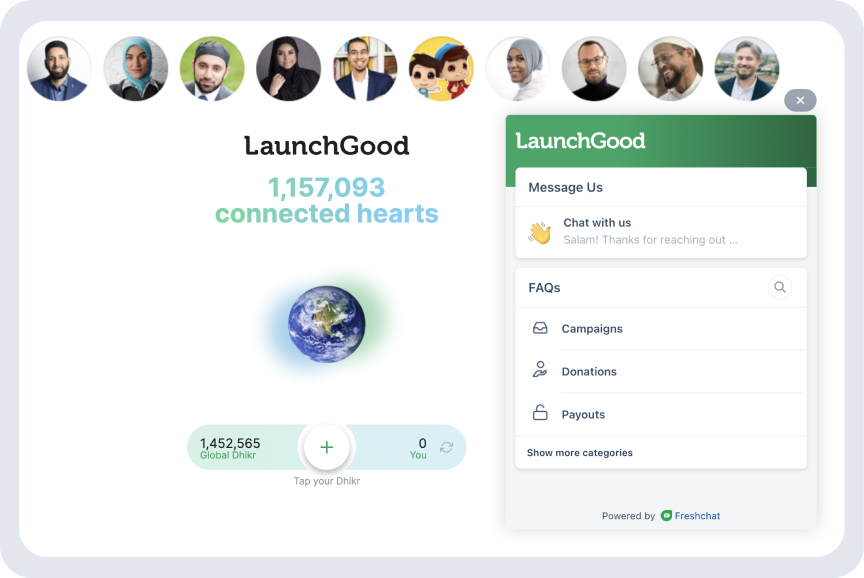
Background
As a rapidly scaling crowdfunding platform, LaunchGood had built a global user base of over one million people who raised more than USD $700 million across 156 countries. But like many growing organisations, its internal systems hadn’t fully kept pace. While user numbers and engagement surged, service delivery relied heavily on individual knowledge, reactive support, and fragmented pathways without a connected ecosystem to translate feedback into action or align teams around end-to-end experience outcomes.
The opportunity was not simply to improve a set of touchpoints, but to build the organisational capability to listen to users, respond to their needs, and continuously improve the service experience. The support experience, while a visible friction point, became the catalyst for a broader CX and service transformation.
The Challenge
As LaunchGood scaled, the customer experience lacked the structure, coherence, and governance needed to support rapid growth. There was no formal Voice of the Customer capability, no clear ownership of the end-to-end journey, and no defined pathways to translate user feedback into product direction. Although feedback flowed in daily, it wasn’t captured, synthesised, or shared, leaving valuable insights untapped. Support, while on the front lines of user interaction, was viewed as reactive and low-value, isolated from strategic conversations and product impact. To move beyond short-term fixes, we needed to build foundational VoC infrastructure, embed it into decision-making, engage executives and product leaders around its value, and introduce design thinking as a way to transform qualitative feedback into roadmap-shaping insight.
Design Opportunity
Reimagine support as a strategic service touchpoint that resolves issues, builds trust, and drives product insight. What if user feedback could guide product and executive decisions, deepen a shared understanding of the customer, and every touchpoint became an opportunity to strengthen the customer journey and the organisation behind it?
Results
The customer experience transformation delivered measurable improvements across user experience, internal efficiency, and strategic alignment. The redesigned support system reduced user drop-off during help-seeking moments, increased engagement with self-service content, and strengthened cross-team coordination around customer feedback.
CSAT surveys provided a consistent mechanism to track experience quality post-interaction. Over 140 content templates were published using the new structure and brand standards, and internal teams reported faster content updates with fewer errors.
The UX Research Table dramatically reduced insight-processing time, transforming feedback from scattered anecdote into structured input for prioritisation. Most significantly, Voice of the Customer insights were formally integrated into product roadmap discussions for the first time, marking a step-change in how LaunchGood listens, learns, and evolves with its users.
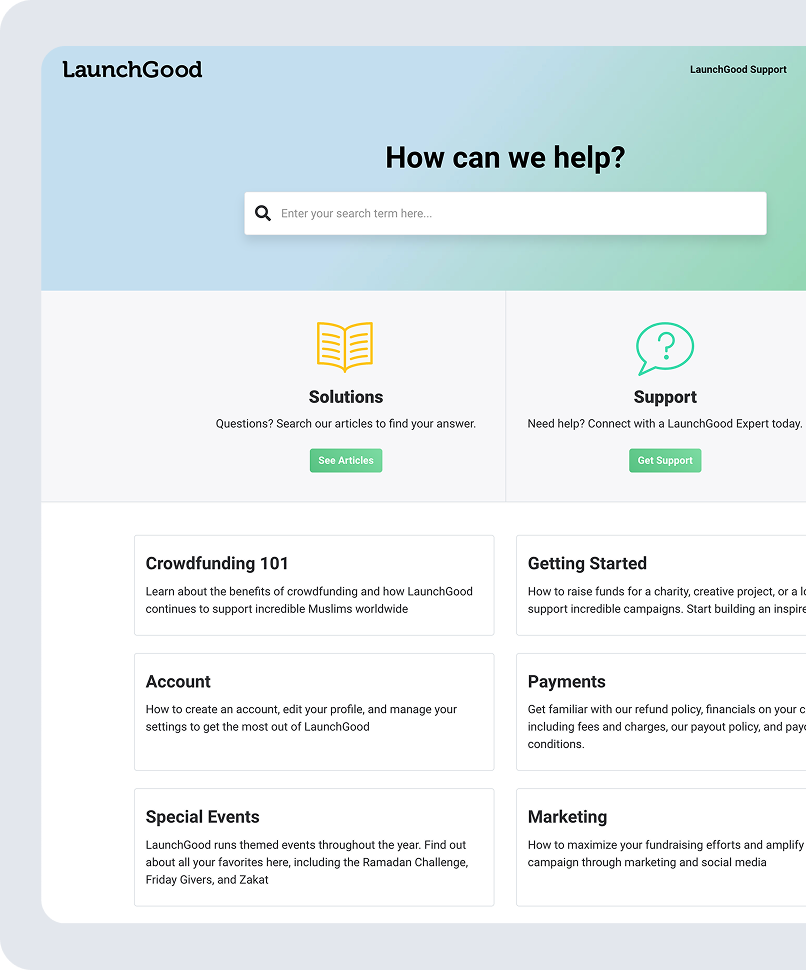

The Solution
We reimagined support as a connected, insight-led service system that would reduce user friction, elevate trust, and surface meaningful product opportunities. The solution focused not just on redesigning visible touchpoints, but on building the internal capability to listen to customers and respond at scale. This meant transforming fragmented channels into a cohesive service experience while embedding Voice of the Customer processes into the way teams worked, prioritised, and improved.
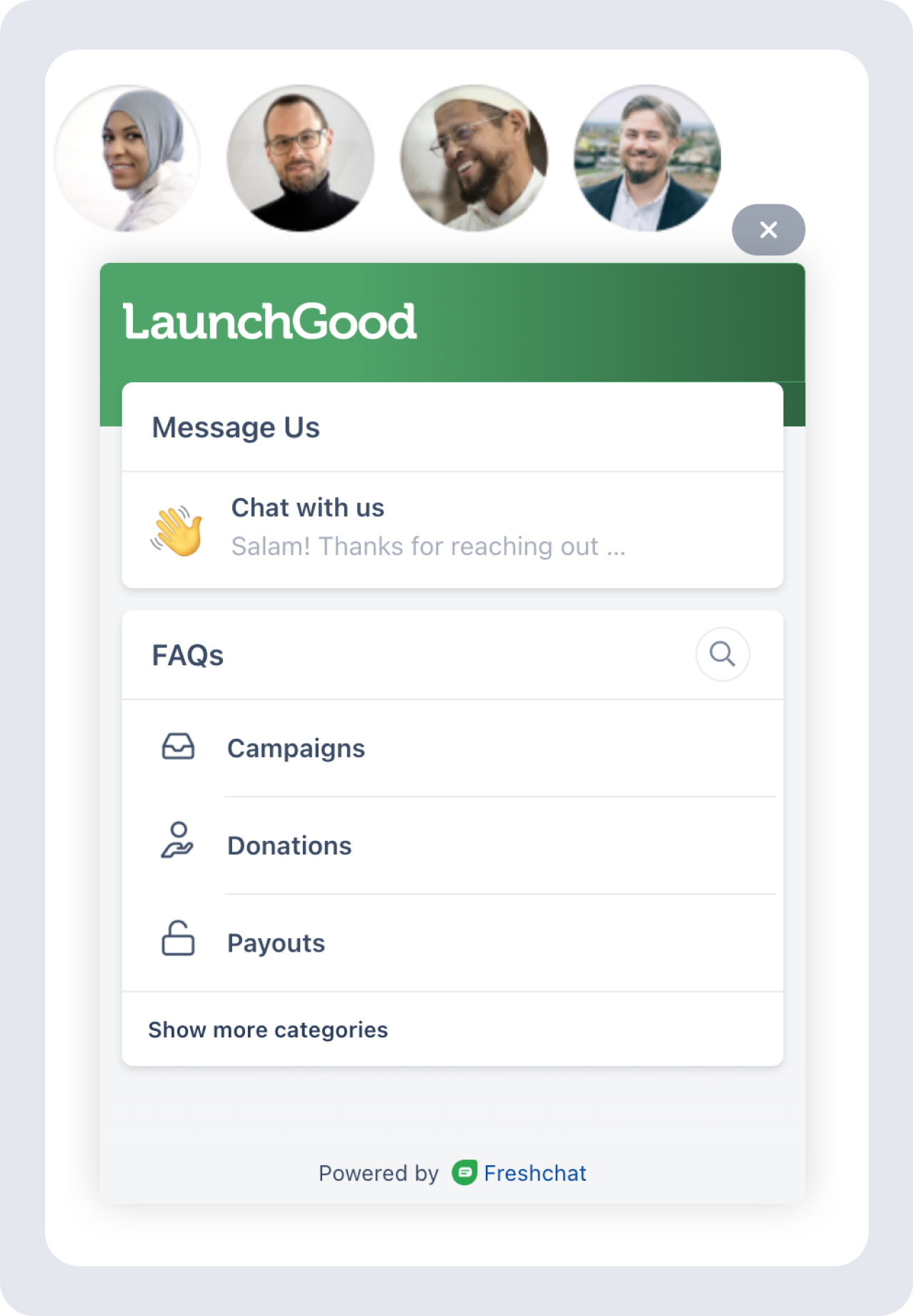
KEY FEATURES:
- Voice of the Customer System: Built a centralised VoC framework to capture feedback across channels, codify insights, and share themes filtered by themes, issues, and personas.
- Persona Development: Developed six foundational personas through synthesis of qualitative and behavioural data, creating a shared reference point that united product, design, and support teams around a source of truth.
- Support Center Overhaul: Re-architected information structure to improve clarity and discoverability, resolved broken links and display inconsistencies, applied UX writing principles to enhance readability, and integrated the support experience across core user touchpoints, including the main platform and live chat.
- Chatbot Redesign: Streamlined conversation flows with intent-based categories, improved escalation logic, and updated UX copy, iconography and interface to align with brand standards, and integrated the chatbot with existing support processes for a more consistent service experience.
- Brand Guidelines & Training: Developed support-specific brand guidelines covering tone, terminology, and language, and delivered internal training to ensure consistency across content and user interactions.
- Content Governance & Agent Enablement: Established a governance system with clear ownership for support content, facilitated co-creation sessions to identify backstage process gaps, created templates and trained support staff to confidently update and maintain content.
- Feedback-to-Roadmap Integration: Delivered structured VoC insights directly into product planning cycles, influencing prioritisation decisions and increasing the visibility of support-generated insight.
Design Methodology And Approach
Discovery And Research
Embedded into the support team, we explored both the external user experience and the internal operational landscape to uncover systemic gaps, surface high-friction moments, and assess organisational readiness for strategic change.
Stakeholder Engagement
- Stakeholder Interviews: Conducted in-depth conversations and real-time observations with product, support, engineering, and compliance teams to uncover service gaps, workflow issues, and operational constraints
- Strategic Alignment: Led cross-functional co-design sessions to assess appetite for repositioning support as a strategic capability, and build momentum for long-term CX maturity
Generative And VoC Research
- Feedback Review & Taxonomy: Analysed support tickets, chat logs, and email transcripts to extract recurring issues, applying a formal taxonomy to identify and categorize key themes
- Content & UX Audit: Audited support articles and chatbot flows to evaluate link health, content duplication, structural clarity, brand and tone consistency
- Information Architecture Benchmarking: Compared IA with leading platforms to identify scalable content patterns and inform the future-state strategy
- Insight Discovery: Conducted exploratory sessions with support agents to surface backstage inefficiencies, tool friction, and escalation challenges
Co-Design Workshops
- Brand & Voice: Facilitated brand alignment workshops with product and design teams to define tone, terminology, and content principles for support communications
- Product Integration: Co-developed approaches for embedding personas into the product design process to better align features with user motivations and needs
- Organisation-Wide Workshop: Brought together teams from across the company to align around a shared source of truth and reframe support as a strategic, insight-generating function capable of informing siloed decision-making
Competitive Benchmarking
- Platform Comparison: Evaluated support models and IA structures from digital leaders to identify best-practice conventions and guide scalable improvements
- Design Thinking Synthesis: Leveraged CX and service design literature to shape recommendations around escalation logic, content governance, and VoC integration
Discovery & Synthesis Methods

Stakeholder
Engagement

Contextual Enquiry

VoC
Analysis

Competitive Benchmarking

Information Architecture

Personas

Affinity
Map

Journey
Map
Systhesis
We synthesised quantitative and qualitative VOC data into actionable themes using structured design artefacts and collaborative analysis to define shared understanding of the current-state experience. Through affinity and empathy mapping, we identified recurring behavioural pain points and emotional drivers across key user segments. We developed a centralised UX Research Repository to codify and categorise VoC data that became the organisation’s source of truth for customer insight. From these insights, we developed six Personas to represent core user types, aligning product, design, and support teams around shared user understanding. We mapped and simplified user flows, using current-state and future-state journey maps to pinpoint opportunities, streamlined service flows and reduce friction across touchpoints.

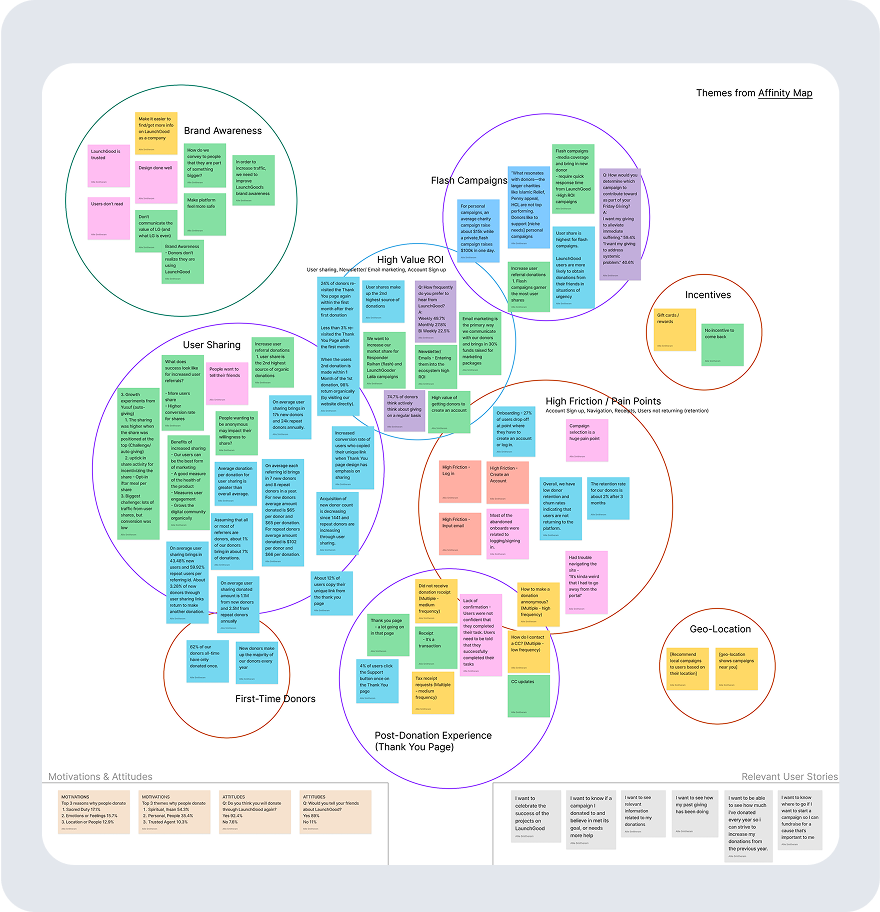
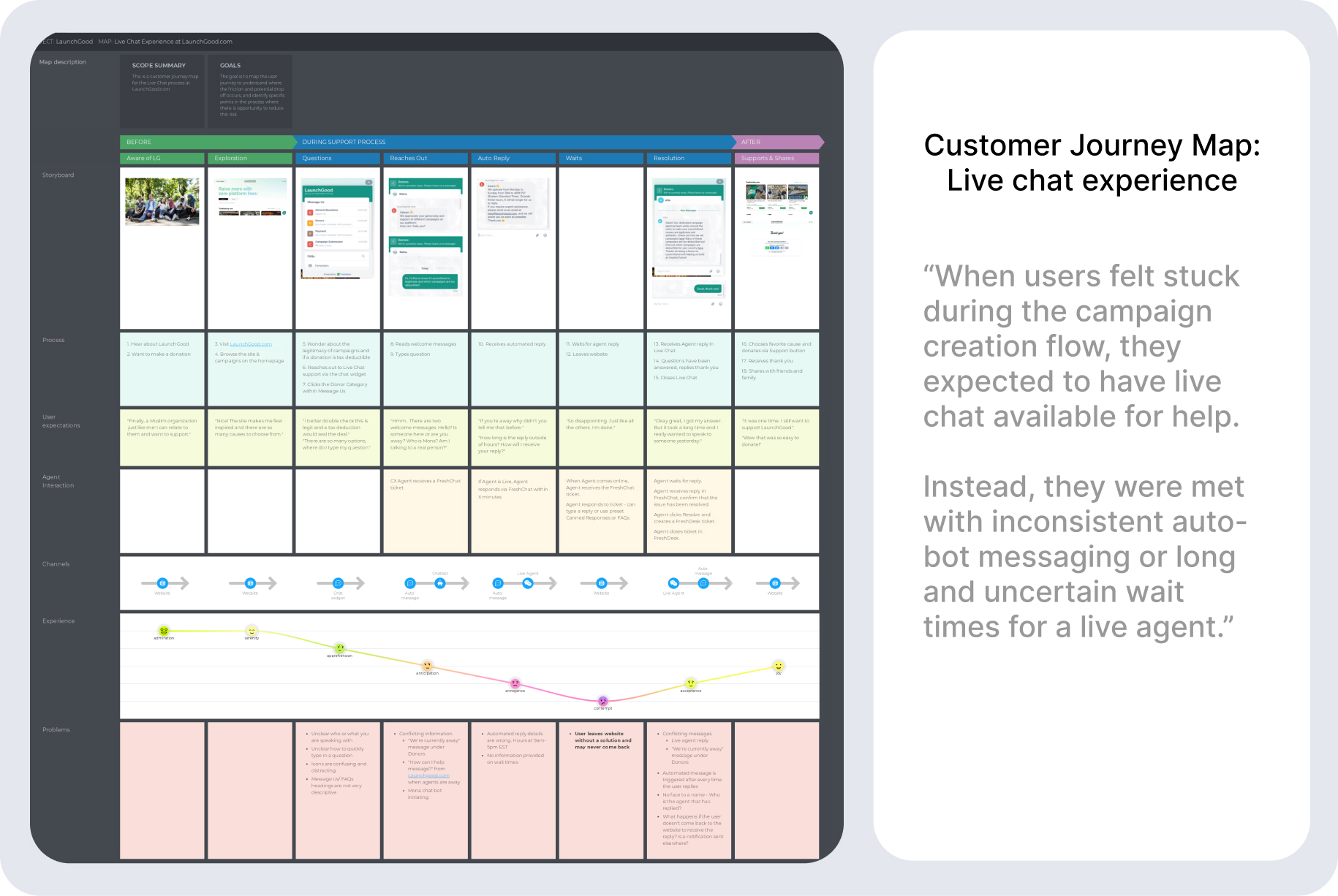
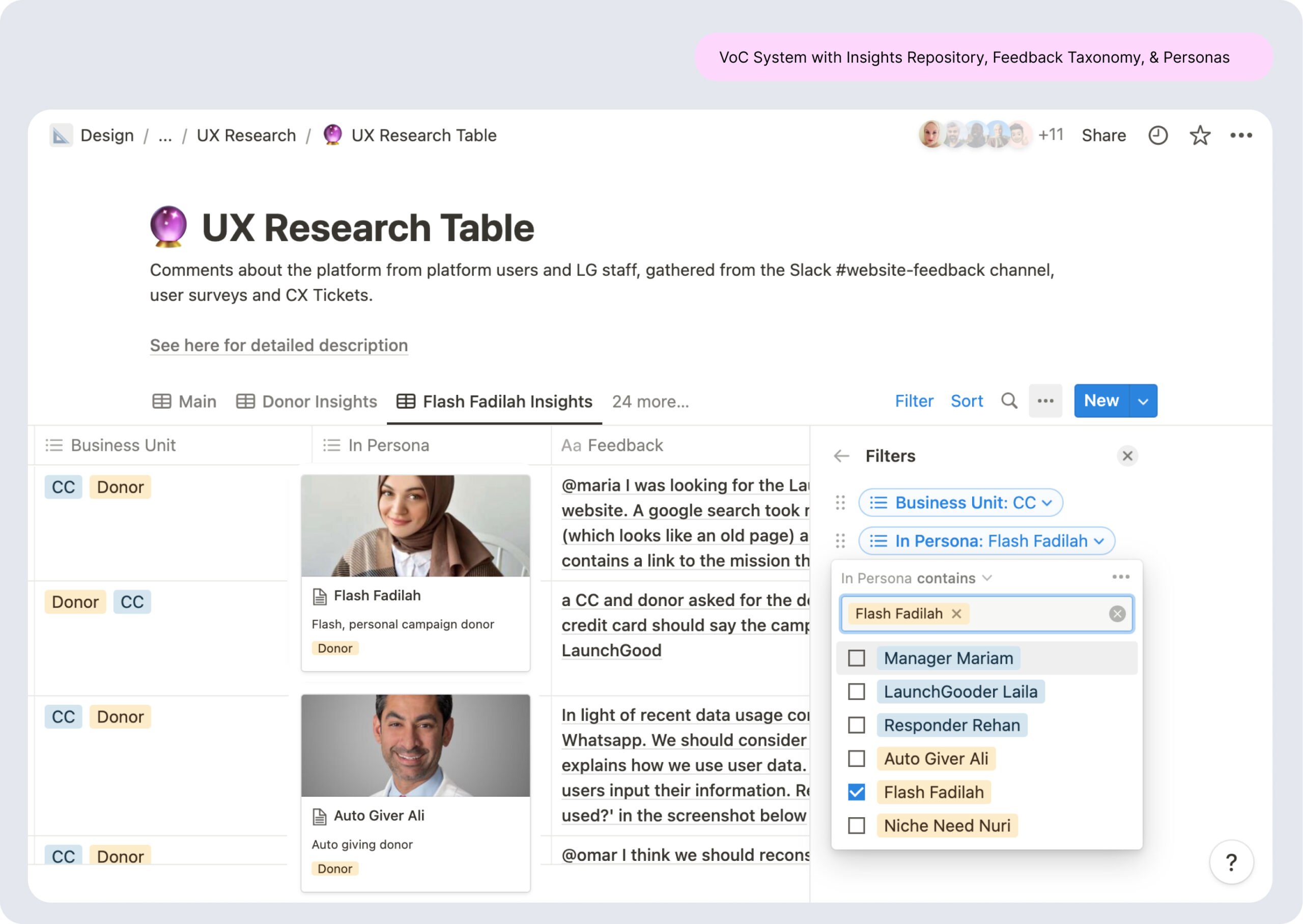
Ideation
From synthesis, a set of high-impact insights emerged revealing not just surface-level usability issues, but deep-rooted service gaps that affected trust, efficiency, and product alignment. We reframed these insights into design opportunities through a series of co-creation sessions that balanced ambition with feasibility, identifying ideas that could deliver immediate value while laying foundations for scalable CX capability. Concepts were shaped around feasibility and impact, ensuring alignment with both personas, VoC themes and organisational priorities, bridging the gap between user needs and service delivery.
Redesign And Implementation
The redesign phase focused on reducing effort, restoring trust, and aligning the support experience with how users actually seek help. Drawing on simplified user flows and prioritised insights, we redesigned the system to provide clearer paths to resolution guided by principles of clarity, predictability, and emotional reassurance in moments of uncertainty. Design decisions were informed by customer insights and refined through co-design sessions with engineering to align with support realities.
Content templates, chatbot flows, and escalation pathways were prototyped and iterated collaboratively with product, design, and support teams, ensuring the system could scale without added complexity. Implementation was staged, beginning with the chatbot and support centre, and included iterative improvements to flow logic, content structure, and UI styling delivered in close collaboration with developers, design, and agents.
Brand and content guidelines were rolled out in parallel, supported by internal training to ensure consistency across live chat and knowledge base content. To embed the work beyond launch, we established a content governance model, trained support agents in article creation and writing standards, and formalised VoC insight sharing with product and design leads. The UX Research Table was maintained as a living source of truth, continuously surfacing user feedback and linking it to roadmap decisions. Qualitative feedback from users and internal teams affirmed a clearer, more consistent experience and repositioned support as a strategic, insight-generating function.

Success Metrics
User Experience:
- Reduced bounce rate during key help-seeking moments through clear and connected self-service flows
- Increased engagement with support articles reflected in improved CSAT scores and positive agent feedback
- Demonstrated consistent tone, structure, and brand alignment across the support experience
Operational Efficiency:
- 140+ articles published using new content templates and governance structure
- Support agents trained, reporting faster content updates, reduced duplication, and fewer errors
- Research processing time dropped from 35 hours to 2 hours by replacing manual affinity mapping with the UX Research Table, enabling faster VoC synthesis and alignment across support, design, and product teams
Strategic Impact:
- Voice of the Customer formally embedded into product roadmap discussions for the first time
- Support function repositioned support as a strategic, insight-generating function
- CX capability was built across product, support, and design teams, enabling long-term content governance, feedback loops, and increased organisational CX maturity
What made it work
- Embedded CX Leadership Led the transformation from within the support team, enabling direct access to frontline insight, building trust, and surfacing operational realities often missed from the outside.
- Cross-Functional Co-Design Brought product, support, design, and compliance teams together through highly collaborative research, co-design, and delivery cycles—ensuring solutions were grounded, feasible, and adopted.
- Strategic Framing and Executive Engagement Reframed the project from a tactical support fix to a CX capability uplift, securing executive buy-in and aligning teams around the long-term value of VoC and service design.
- Systems Thinking, Not Surface Fixes Connected frontstage and backstage service elements through journey maps, governance models, and shared artefacts, addressing root causes rather than symptoms.
- Living Artefacts and Sustainable Handover Delivered not just outputs, but enduring systems—personas, brand guidelines, content governance, and a live UX Research Table—ensuring the work scaled and remained useful post-implementation.
Reflection and impact
Transforming support wasn’t just a design challenge, it was a systems challenge. The real impact came from shifting how the organisation listened, responded, and worked together to deliver service. The most enduring outcomes weren’t the visible changes to chat or content, but the internal alignment, capability uplift, and new ways of making decisions around the customer. This project showed that when you embed design deeply, build shared ownership, and treat insight as infrastructure, support can evolve into a high-impact, intelligence-generating part of the business.
WORK TOGETHER?
I'd love to hear from you! Send a message & I'll be in touch as soon as I possibly can.